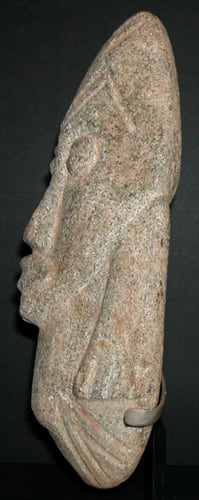Bakor Basalt Ancestor Sculpture, 14th Century CE - 16th Century CE
Basalt
6.25 x 14
SP.124
Further images
The peoples of the Cross River region of Nigeria have been creating monoliths from basalt since around 200 A.D. These carvings range in size from around two feet to over...
The peoples of the Cross River region of Nigeria have been creating monoliths from basalt since around 200 A.D. These carvings range in size from around two feet to over six feet. Carved with human features, these massive monuments were traditionally arranged in circular formations facing inwards. Stone carvings are quite rare in Sub-Saharan Africa, where the preferred medium is wood. Those carvings embellished with human features are even more uncommon, making a work such as this one exceedingly rare. Considering that these monolithic circles have been found in the forest or at the site of long abandoned settlements, it is unlikely that the Ejagham/Bakor ethnic group that inhabits this region today were the original creators of these pieces. Instead, they claim that the stones were created by divine spirits and emerged from the ground like trees. Although we can only speculate at their original meaning, scholars presume that the stone were found in rivers and carried to the towns where they were carved. It is speculated that the sculptured stone figures represented either an ancestor, a legendary or history figure, or an emblem of a secret society. Regardless of their original meaning, their size, weight, and durability all reveals the importance of these works. The fact that the Bakor continue to revere and perhaps even produce such pieces further attests to their significance.





